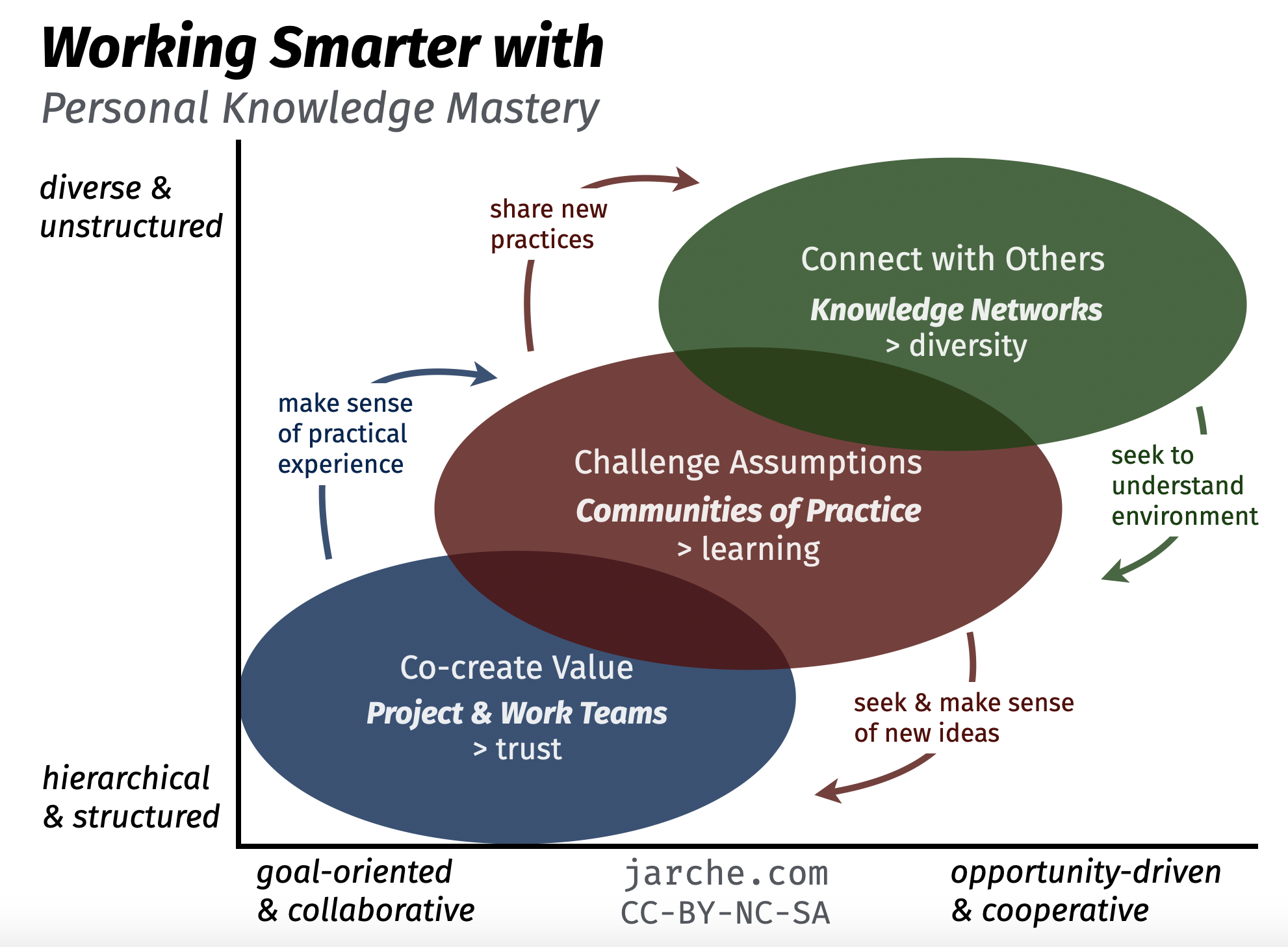In 2010 we conducted a project to cultivate a fully engaged, high performing workforce through rapid, collaborative, informal, & self-directed learning at a US-based health insurance company of about 20,000 employees. It is summarized in the working smarter case study.
Jump ahead a decade and similar issues continue to face large organizations.
My recent client challenge with Citibank in 2019/2020 can be summed up as — How do you improve collaboration, knowledge-sharing, and sensemaking in a globally distributed company with over 200,000 employees?
We started by grounding on first principles.
- Fostering collaboration, but avoiding collaborative overload.
- Optimizing how work gets done.
- Freeing up time for intentional learning.
- Rewarding collective innovation.
Several initiatives were started and one was based on the personal knowledge mastery framework which became the core of a new program piloted in mid-2020 — Working Smarter @ Citi. It began just as the pandemic hit and everyone suddenly went to remote work. In hindsight, it was the perfect program to help a distributed workforce.
The Working Smarter program included four modules spaced over four weeks:
- Sparking curiosity
- Knowledge seekers
- Sense makers
- Network catalysts
Participants were organized in cohorts of 50 or fewer participants and the program included individual exercises and collective discussions. A core part of Working Smarter was having each participant select a topic or subject they wanted to learn more about. It did not have to be work related. Participants progressed through the activities within the context of their own learning objective. Some even learned that they had picked a subject that was much too difficult to learn in four weeks.
While the program was based on the personal knowledge mastery framework, examples came from employees found through extensive interviews conducted over several months. Many insights were discovered in the interview process. We heard comments that there was no easy access to knowledge across divisions and regions. Pretty well everyone agreed that finding the right people and right information was often difficult.
One person commented that those closest to customers and competitors are more open to learning and change. Another asked how could we get back-office staff to have the same sense of urgency and responsiveness that client-facing staff have. A senior staff member suggested we should reward groups or teams rather than individuals to promote collaboration. One insightful comment was that sharing and cooperating have to be seen as part of the work.
Here are some comments from the program participants.
“I feel like we’re on a 4-week virtual team building activity!”
“the content in this program is really insightful and it offers tips and suggestions that are very useful in a practical, not just academic, manner and easily applicable to our specific work situations, projects and challenges. I’ll definitely be using many of them going forward.”
“The program has something for everyone, right from who is just starting their career to someone in the middle management to one who is right on top of the food chain.”
“It truly takes an ‘army’ to sort/sift/review the never-ending information flow, make sense of it, and decide what actions to take. I hope this course has a cultural impact on the firm, such that folks continue to share their knowledge, aren’t afraid to ask questions, and work together for the greater good.”
The second pilot extended the time for each module to two weeks for a total of almost two months. This next iteration involved managers to follow each participant’s progress, so that what is learned in the program can be integrated into the specific work context. This time, two types of cohorts were established — new hires and intact teams. Each cohort comprised people who had volunteered to do the program.
The Working Smarter program helped to establish some core ideas and frameworks to further conversations in the workplace. It positioned curiosity as a key to workplace learning. It helped people understand that it is a good practice to narrate our work and connect with others outside our work teams. The examples provided by employees gave tangible methods to improve collaboration, knowledge-sharing, and sensemaking across the enterprise.
The feedback from the +300 person pilot programs was overwhelmingly positive. An early complaint was that there was not enough time which is why the second pilot was longer. We know that lack of time remains a challenge and that time has to be made for reflection and learning. One way to address the time crunch is to improve how meetings are conducted and how often. The time saved in conducting more effective and efficient meetings can then be used to put some slack into the daily routine, and use it to learn and work smarter.
Currently there are about 5,000 participants per quarter taking the Working Smarter program.
The Working Smarter with PKM field guide provides an overview of the framework behind this initiative.
2022 Updates
The Working Smarter at Citi program now has about 200 volunteer coaches who have taken the program and then offer their services to another cohort. Feedback on what to change has predominately been — don’t change anything. The program, which started at four weeks, was expanded to eight, is now six weeks long.

OEB22




1 thought on “working smarter 2020”